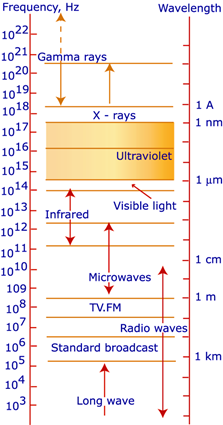Electromagnetic Waves
Electromagnetic Waves PDF Notes, Important Questions and Synopsis
SYNOPSIS
- Displacement current is due to a time-varying electric field and is given by .

- Displacement current acts as a source of a magnetic field in exactly the same way as conduction current.
- Maxwell’s equations and plane electromagnetic waves.
Gauss’s law for electricity
=
Gauss’s law for magnetism
Faraday’s law

Ampere’s law

These equations are collectively known as Maxwell’s equation. - Electromagnetic waves are produced only by charges which are accelerating, because acceleration is absolute and not a relative phenomenon. An electric charge oscillating harmonically with frequency ν produces electromagnetic waves of the same frequency ν.
- An electric dipole is a basic source of electromagnetic waves.
- Electromagnetic waves with wavelength of the order of a few metres were first produced and detected in the laboratory by Hertz in 1887. He thus verified a basic prediction of Maxwell’s equations.
- lectric and magnetic fields oscillate sinusoidally in space and time in an electromagnetic wave.
- The oscillating electric and magnetic fields E and B are perpendicular to each other and in the direction of propagation of the electromagnetic wave.
- For a wave of frequency ν, wavelength λ and propagating along the z-direction, we have

- They are related by E0/B0 = c
- The speed c of an electromagnetic wave in vacuum is related to m0 and e0 (the free space permeability and permittivity constants) as follows:

The value of c equals the speed of light obtained from optical measurements. Light is an electromagnetic wave. c is therefore the speed of light.
Electromagnetic waves other than light also have the same velocity c in free space.
The speed of light or of electromagnetic waves in a material medium is given by ,
Where µ is the permeability of the medium and its permittivity.
its permittivity. - Intensity
Energy crossing per unit area per unit time perpendicular to the direction of propagation is called intensity of a wave.
In terms of maximum electric field, intensity is written as
- Electromagnetic waves carry energy as they travel through space, and this energy is shared equally by the electric and magnetic fields.
- In a region of space in which there exists electric and magnetic fields
 , there exists energy density (energy per unit volume) associated with these fields which is given by
, there exists energy density (energy per unit volume) associated with these fields which is given by
Where we assume that the concerned space consists of vacuum only. - Electromagnetic waves transport momentum as well. When these waves strike a surface, a pressure is exerted on the surface. If the total energy transferred to a surface in time t is U, the total momentum delivered to this surface is p = U/c. If the wave is totally reflected, the momentum delivered to the surface of the material is 2U/c, because the momentum of the wave changes from p to –p. It follows that electromagnetic waves incident on a surface exert a force on the surface.
- The spectrum of electromagnetic waves stretches, in principle, over an infinite range of wavelengths. The electromagnetic spectrum classifies electromagnetic waves according to their frequency. There is no sharp division between one kind of wave and the next. The classification has more to do with the way these waves are produced and detected. Different regions are known by different names-g-rays, X-rays, ultraviolet rays, visible rays, infrared rays, microwaves and radio waves-in the order of increasing wavelengths from 10−2 Å or 10−12 m to 106 m.

The accelerated charge is the basic source of electromagnetic waves. This produces changing electric field and changing magnetic field which constitute the wave. Among the electromagnetic waves, visible light is most familiar to us. This is emitted by atoms under suitable conditions. An atom contains electrons, and the light emission is related to the acceleration of an electron inside the atom. The mechanism of emission of ultraviolet radiation is similar to that for visible light.
Download complete content for FREE 
NEET - Physics
Asked by begfatima123 | 06 May, 2022 04:21: PM
Related Chapters
- Physics and Measurement
- Kinematics
- Laws of Motion
- Work, Energy and Power
- Rotational Motion
- Gravitation
- Properties of Solids and Liquids
- Thermodynamics
- Kinetic Theory of Gases
- Oscillations and Waves
- Electrostatics
- Current Electricity
- Magnetic Effects of Current and Magnetism
- Electromagnetic Induction and Alternating Currents
- Optics
- Dual Nature of Matter and Radiation
- Atoms and Nuclei
- Electronic Devices
- Communication Systems

